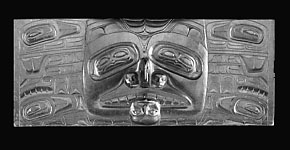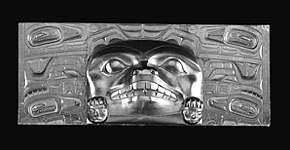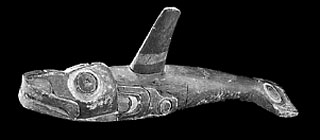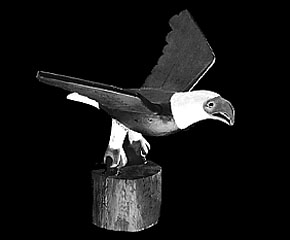 |
The mythology of the Haida, like that of other tribes on the central and northern coast, is based on the epic cycle of stories about the Raven and his various exploits. The Raven is truly a trickster who liberates humankind from a clamshell, then in one story sets the universe in order, only to threaten it with chaos in the next. The Raven is the most greedy, mischievous and lecherous creature imaginable, but almost without meaning to, teaches humans the arts of living a good life. Haida artist Charles Edenshaw alone could recount several hundred different Raven stories from memory.
One of the best-known of these stories tells how the Raven disguised himself in order to enter the house of the Sky Chief, from whom he stole the sun, moon and stars to give to humankind. In another popular tale, the Raven was hungry, so decided to swim underwater to eat the bait off the hooks of some halibut fishermen. However, the hook lodged solidly in his beak. The fishermen banded together to haul up what they thought was a huge halibut, but got the Raven's beak instead.
Many stories describe the Raven's encounters with supernatural beings and how he acquired other useful things for humans from them, such as fresh water, salmon, the fish weir and the house -- the latter from the Beaver.


Most Haida objects are decorated with crests -- figures of animals, birds, sea creatures and mythic beings -- that immediately identify the moiety (Raven or Eagle) and often the lineage of the owner. On a more subtle level the placement of a crest figure, and especially the smaller figures attached to its ears, chest or mouth, refer to a specific myth involving that crest. An example is the Edenshaw family's frequent use of the Butterfly on the chest of the Raven, which refers to a series of myths in which the Butterfly is the Raven's travelling companion in the Masset series of stories. In the Skidegate series of myths, however, it is the Eagle who accompanies the Raven on his travels. Details such as these make it difficult to read the full range of meaning on a totem pole without a thorough knowledge of the mythology, but there is no one alive today who is familiar with the thousands of myths that have been recorded in various museum archives. Hence, the "text" that can be associated with a particular pole is similar to a Mayan text, in that only a few glimpses are possible.
Around 1900, John R. Swanton worked out a list of crests with information from such knowledgeable Haida artists as Charles Edenshaw of Masset, John Cross and John Robson of Skidegate, and Tom Price of Ninstints. These men all had an intimate working knowledge of the mythology and how crest designs should be used on everything from tattoos to totem poles. Tattoos were put on the thighs, chest, shoulders, forearms, backs of the hands and even all of the sections of fingers.

Although the Haida have almost seventy crest figures, less than a score are in general use. A few crest figures were used by many lineages, and a larger number were exclusive to a few lineages. The Killer Whale, which is a particularly strong feature of Haida art and myth, is a popular crest. All Raven lineages use forms of the Killer Whale as a crest; one of them, the Raven-Finned Killer Whale, refers to the myth in which Raven pecked himself out of the body of a Whale through the end of its dorsal fin. Eagle lineages of Ninstints use only the Five-Finned Killer Whale, which links them to specific Killer Whale chiefs whose undersea village was near their own and with whom their mythic ancestors had a profitable experience. The tall dorsal fin of Killer Whale crests that belong to Ravens are always black, while those of Eagles have a diagonal white stripe.
All of the land mammals used as crests, except for the Beaver, belong to the Raven moiety. Some of these crests such as the Mountain Goat, the Wolf and the Grizzly are of animals that do not occur on Haida Gwaii; their use was transferred from Tsimshian chiefs on the mainland. All crests of amphibious creatures such as the Beaver and the Frog are the exclusive prerogative of the Eagle moiety and also originated with the Tsimshian. Sea mammals mostly belong to the Ravens, although many Eagle lineages use the Blackfish as a crest. Fish crests are heavily weighted in favour of the Eagle moiety, who use the Sculpin, Skate, Dogfish, Starfish and Halibut. The Ravens share with them the Dogfish and the Skate.

The Raven moiety does not use the Raven as a crest, but the Eagle moiety does use its namesake frequently, as well as many other bird crests including the Raven, Cormorant, Heron, Hawk and Hummingbird. The only bird crests the Raven moiety uses are the Flicker, Hawk and Horned Owl.
|